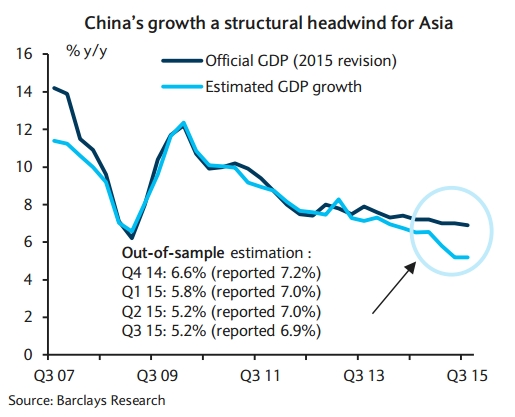Beijing has rolled out a raft of support steps to avert hard landing in the economy, including cutting interest rates six times in the past year, but the stimulus has been slower to take effect. Data earlier in the month showed that China's manufacturing industry unexpectedly contracted for a third straight month, missing market hopes for a break-even 50.0 reading. The world's second-largest economy grew 6.9 percent in the third quarter from a year earlier, the weakest pace since the global financial crisis. However, the latest economic indicators in general point to a continued deterioration in real activity, in sharp contrast to the flat sequential growth momentum suggested by the official Q3 GDP print of 6.9%.
However, there are a few emerging positive signs, with property sales and prices appearing to be on an uptrend, and household loans for housing have improved slightly as well. The PBoC along with cutting the policy rate 125bp through 2015, has also eased macro prudential measures to ease the housing glut and slump in building activity. Retail sales growth has also been holding up, with online retail growth remaining especially robust. Chinese President Xi Jinping told G20 leaders meeting in Turkey on Sunday that China was able to keep up medium to high economic growth and expects this year's growth to be around 7 percent, which would nevertheless be the weakest in a quarter of a century. Analysts expect more monetary policy easing from PBoC in H1 16 (taking the RRR and benchmark rate 50bp lower).
India and Indonesia are showing more signs of promise. In India, the RBI has delivered 125bp of cumulative policy easing, which is helping reduce debt servicing costs and improving retail loan demand. The underlying activity has been improving at a faster pace, with private consumption and public investment leading the pick-up amid declining inflation. In recent months, there has been a broadening in sectors that are doing better, and the buoyancy of domestic activity is illustrated in improving car sales, rising aviation traffic, and improving consumer goods production.
In Indonesia, after the cabinet reshuffle in August, the pace of implementation of public investment projects has improved, helped by better coordination among government agencies. Although Q3 growth was still slow, we expect public spending to be the key growth driver in Q4. A decline in inflation to a one-year low and economic growth trailing estimates would typically spur Indonesia's central bank to cut interest rates. Indonesian business associations and government officials have repeatedly called for a rate cut to stimulate the economy. But BI Governor Agus Martowardojo said earlier today that the c.bank will be cautious in easing monetary policy. As inflation also rolls down, Bank Indonesia could start easing monetary policy - from November - and into 2016.
While noting that the monetary review will be a close call, Barclays analysts Wai Ho Leong and Angela Hsieh expect BI to announce a 25-basis-point rate cut this month due to the "rolling down of the inflation trajectory, coupled with better external balance."
China, India and Indonesia plan extra monetary stimulus in 2016

Tuesday, November 17, 2015 11:53 AM UTC
Editor's Picks
- Market Data
Most Popular



 Ukraine recap: US$60 billion aid package brings fresh hope to desperate Kyiv
Ukraine recap: US$60 billion aid package brings fresh hope to desperate Kyiv  South Africa’s youth are a generation lost under democracy – study
South Africa’s youth are a generation lost under democracy – study  Vaping now more common than smoking among young people – and the risks go beyond lung and brain damage
Vaping now more common than smoking among young people – and the risks go beyond lung and brain damage  Family farms are fast disappearing: our research shows how young generations can take them up successfully
Family farms are fast disappearing: our research shows how young generations can take them up successfully  How visas for social care workers may be exacerbating exploitation in the sector
How visas for social care workers may be exacerbating exploitation in the sector  Tarantino abandons his tenth film – five other times Hollywood giants cancelled big projects
Tarantino abandons his tenth film – five other times Hollywood giants cancelled big projects  The politics stopping the UK from opening a youth mobility scheme with Europe
The politics stopping the UK from opening a youth mobility scheme with Europe  New ‘cold war’ grows ever warmer as the prospect of a nuclear arms race hots up
New ‘cold war’ grows ever warmer as the prospect of a nuclear arms race hots up  History for sale: what does South Africa’s struggle heritage mean after 30 years of democracy?
History for sale: what does South Africa’s struggle heritage mean after 30 years of democracy?  How breakdancing became the latest Olympic sport
How breakdancing became the latest Olympic sport 






























